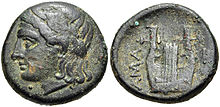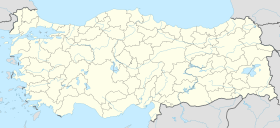Hamaxitus
Ἁμαξιτός | |
| Location | Gülpınar, Çanakkale Province, Turkey |
|---|---|
| Region | Troad |
| Coordinates | 39°32′18″N 26°5′35″E / 39.53833°N 26.09306°E |
| Type | Settlement |
| History | |
| Builder | Colonists from Mytilene |
| Founded | Possibly during the 8th or 7th centuries BC |
| Abandoned | Possibly after the 7th or 8th century AD |

Hamaxitus (
Name
Hamaxitus first appears in the
Apollo Smintheus
All foundation myths about Hamaxitus in
The earliest tradition comes from Callinus, an elegiac poet from Ephesus who lived in the mid-7th century BC. He relates that Hamaxitus was founded by a band of Teucrian (i.e. Trojan) Cretans who were told by an oracle to found a city wherever the 'earth-born' (γηγενεῖς) attacked them. When they reached the area of Hamaxitus, a great horde of field mice ate all the leather on their equipment, and so they settled on the spot, interpreting the 'earth-born' of the oracle to have been the mice. This myth thus glosses the term sminthos as 'mouse'.[14] Callinus' aetiology takes into account both Apollo's role as a god of disease and the fact that it was in precisely this role that Chryses had invoked him as 'Sminthian' in the Iliad. However, in discussing the cult, the Augustan Greek geographer Strabo of Amaseia noted that the epithets of gods worshipped at several other Greek sanctuaries were also explained by reference to a god bringing an end to a plague of small animals, and so it is not clear how Callinus arrived at this specific explanation of sminthos as 'mouse'.[15] The term appears again as a poetic word for mice several centuries later in a fragment of the early 5th century BC tragedian Aeschylus, indicating that by this time Callinus' aetiology of 'Sminthian' had been generalized from an explanation of a particular epithet into an independent lexeme.[16]
Callinus' version predominated in Classical Antiquity and is reflected in the local traditions of Hamaxitus.
Gallery
History
Archaic and Classical
Hamaxitus is believed to have first been settled by Mytilenaeans in the 8th or 7th centuries BC; however, insufficient excavation has been done at the site to prove this definitively.[23] It was one of the Actaean cities in the Troad which Athens took from Mytilene following the end of the Mytilenean revolt in 427 BC and appears in tribute assessments for 425/4 and 422/1 BC.[24] In 425/4 BC it had an assessment of 4 talents, a relatively high figure compared to other cities in the Troad; a large part of this wealth would have been derived from the salt pans at nearby Tragasai, which records from the Ottoman period indicate could be highly productive.[25] A fragment of the so-called Standards Decree, which dates to the 420s BC and imposed the use of Athenian weights, measures, and coins on members of the Delian League, was found at the nearby village of Gülpınar.[26]
Following the defeat of Athens at the end of the
Hellenistic and Roman
In c. 310 BC
The settlement at Hamaxitus appears to have survived at least until the early Roman period following its synoecism with Alexandreia Troas (the city had been renamed from Antigoneia Troas following the death of Antigonus at the Battle of Ipsus in 301 BC). The fame of Apollo Smintheus only increased following the synoecism, which rebuilt the temple, created a new festival in the god's honour, and featured Apollo Smintheus on its coins until the mid-3rd century AD.[37] The Smintheum continued to appear on Roman and early mediaeval itineraries such as the Tabula Peutingeriana (4th or 5th century) and the Ravenna Cosmography (7th or 8th century).[38] It is therefore likely that the port at Beşiktepe was still used by pilgrims, even if the settlement of Hamaxitus had long since declined.[39]
References
- Naturalis Historia5.124.
- ^ Strabo 10.3.21.
- Classical Antiquityas Ἁλήσιον πεδίον (Halesion pedion), 'the salt plain'.
- ^ Cook (1973) 231.
- ^ IG I3 71.III.129: h[αμαχσιτός]; IG I3 77.IV.18: [Ἁμαχ]σιτός (square brackets indicating a restoration). For the divergent spellings, see Carusi (2003) 34-5.
- ^ Carusi (2003) 35 n. 23.
- ^ Goodwin (1894) §28.3.
- ^ The 'series 1' coinage (4th century BC): Bresson (2007) 150.
- LSJs.v. ἁμαξιτός.
- ^ Cook (1973) 233-4. For other sites with similar etymologies, see Stephanus of Byzantium s.v. Ἄμαξα, Ἁμαξαντία, Ἀμαξία, Ἀμαξιτός.
- ^ Homer, Iliad 1.39.
- ^ Chantraine (1980) s.v. σμίνθος.
- ^ Finkelberg (2005) 42-64.
- ^ Strabo, Geography, 13.1.48 = Callinus T 4 (ed. Gerber); Dougherty (1994) 37-8.
- ^ Strabo, Geography, 13.1.64; Hekster (2002) 367-8.
- Aetiafr. 117.16.
- JSTOR 284230. Retrieved November 15, 2023.
- ^ "Bronze As of Gallienus, Alexandreia Troas, AD 260 - AD 268. 1944.100.43746". American Numismatic Society. Retrieved 31 March 2022.
- Scopas of Paros: Grace (1932).
- ^ "Smintheum". www.livius.org. Archived from the original on 2013-08-13.
- ^ Bresson (2007) 154-5, citing the excavations reports of Özgünel (2001).
- ^ Athenaeus 3.74f–75a, 10.445a-b = Philomnestus, BNJ (= Brill's New Jacoby) 527 F 1-2 (ed. Stronk); very little is known about Philomnestus except that he dates before Athenaeus (i.e. c. AD 170 – c. 230). Sminthios is also attested as a month-name at Pergamon, Nisyros, and Paphos.
- ^ Cook (1973) 235.
- ^ IG I3 71.III.129, IG I3 77.IV.18.
- ^ Cook (1973) 222-4, Cook (1988) 13, Ricl (1997) 198-200, T 59-64, Bresson (2007) 142-4. The name of the Tuzla Çay, which passes through these salt pans, means 'salty river' in Turkish.
- ^ SEG 38.1251. The fragment belongs to a copy of the original decree, IG I3 1453, which had been set up at Hamaxitus. Several further fragments have subsequently been published, e.g. the Aphytis fragment: SEG 51.55.
- ^ Xenophon, Hellenica 3.1.13, 16, Diodorus Siculus 14.38.3.
- ^ Bresson (2007) 150-1, who provides a complete and up-to-date list of references.
- ^ Cook (1973) 234 reports finds at Küçük Kuyu, Ezine, Baymariç, Akköy, and Limantepe.
- ^ Amphorae: Cook (1973) 231. Tax exemption: I.Alexandreia Troas 3 (ed. Ricl); see now Bresson (2007) 147-50.
- ^ Ancient testimonia: Ricl (1997) 186-205.
- ^ Synoecized at once: Cook (1973) 231, 234, Cook (1988) 15-17. Part of initial synoecism, then left in 3rd century BC, then joined again after the Treaty of Apamea: Robert (1946) 506-23, Robert (1982) 319-33. First synoecized c. 188 - c. 171 BC: Bresson (2007).
- ^ Bresson (2007) 151.
- ^ Bresson (2007) 156.
- ^ Ricl (1997) 198-200, T 59-64.
- ^ Nikomedes of Kos: IscrCos ED 71g B.6. Thearodokoi: Bresson (2007) 153 n. 60.
- ^ For continuing interest in the cult see Ricl (1997) 189-94 T 39.
- ^ Ricl (1997) 190, T 39.5-7.
- ^ Bresson (2007) 156.
Bibliography
- W. W. Goodwin, Greek Grammar Rev. ed. (London, 1894).
- V. R. Grace, 'Scopas in Chryse' JHS 52 (1932) 228–232.
- L. Robert, 'Villes de Carie et d'Ionie dans la liste des théorodoques de Delphes' BCH 70 (1946) 506–23.
- P. Chantraine, Dictionnaire étymologique de la langue grecque: histoire des mots, 4 vols. (Paris, 1968–80)
- J. M. Cook, The Troad: An Archaeological and Topographical Study (Oxford, 1973) 231–5.
- L. Robert, 'Documents d'Asie Mineure' BCH 106 (1982) 309–78.
- J. M. Cook, 'Cities in and around the Troad' ABSA 83 (1988) 7-19.
- C. Dougherty, 'Archaic Greek foundation poetry: questions of genre and occasion' JHS 114 (1994) 35–46.
- M. Ricl, The Inscriptions of Alexandreia Troas (Bonn, 1997) 196–201.
- C. Özgünel, Smintheion, Troas’ta Kutsal bir Alan (Ankara, 2001).
- O. Hekster, 'Of mice and emperors: a note on Aelian De natura animalium 6.40' CP97.4 (2002) 365–70.
- C. Carusi, Isole e Peree in Asia Minore (Pisa, 2003) 34–5.
- S. Mitchell, 'Hamaxitus' in M. H. Hansen and T. H. Nielsen (eds), An Inventory of Archaic and Classical Poleis (Oxford, 2004) no. 778.
- M. Finkelberg, Greeks and Pre-Greeks: Aegean Prehistory and Greek Heroic Tradition (Cambridge, 2005).
- A. Bresson, ‘Hamaxitos en Troade’ in J. Dalaison (ed), Espaces et pouvoirs dans l’Antqiuité de l’Anatolie à la Gaule. Hommages à Bernard Rémy (Grenoble, 2007) 139–58.
External links
- Smintheum at Livius.org









